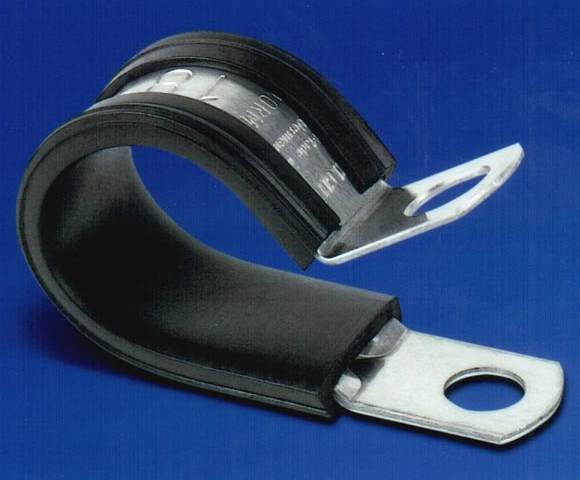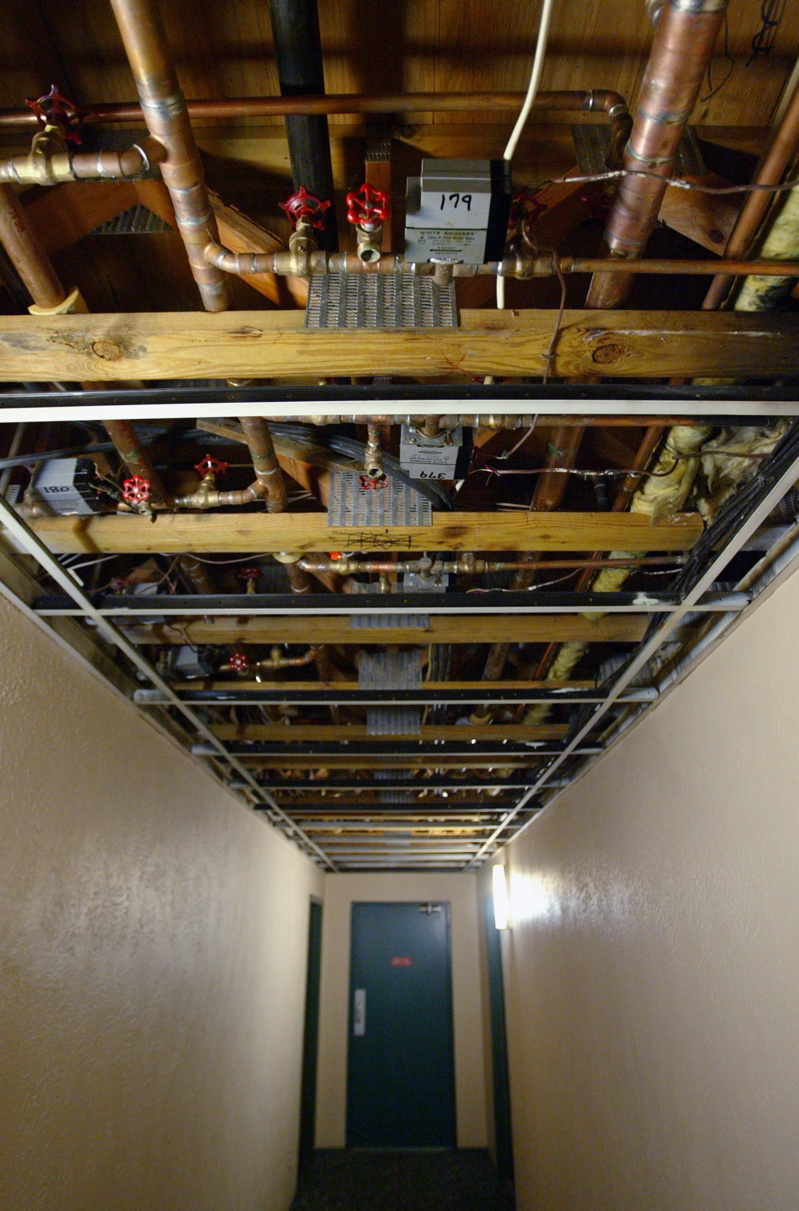Materials, tools, complexity of work - everything will depend on the prepared plan. Wiring in the apartment implies a clear scheme. And only then everything else: the purchase of the necessary, the planning of work, the installation of the pipeline system.
Making a plan
- First, in an apartment water supply always means connecting to centralized network. Therefore, the scheme must be adjusted to the existing water supply points.
- Secondly, it is necessary to analyze the connection points of appliances, plumbing.
- Thirdly, we distribute all possible points of water consumption throughout the room: plumbing in the bathroom, in the bathroom and in the kitchen.
- Fourthly, we select pipes that are suitable in size and draw up schemes for their installation. On this stage you should also decide on the methods of joining pipes and system elements, calculate required amount materials: fittings, fittings, water filters. Stock up on tools.
The arrangement of emergency cranes and valves will complete the development of the plan.
Having collected all necessary information Let's start drawing the system. It is possible to connect a water heater (boiler) - the water supply system will partially become autonomous. Start drawing with a plan of the rooms, arrange them in a real sequence. Put a water supply scheme on it from centralized system, and its autonomous (if available).
Further - in the best traditions of the city water utility. The scheme evolves into project documentation With detailed description materials used, flow pressure indicator. And even including chemical composition water. Here are the rules for operating counters.
The scheme is coordinated with local authorities.
Types of wiring
The features of piping are affected not only by the places where water is supplied from the central system, but also specifications the premises and the building as a whole.
There is also a classification: from the most difficult to the most simple species schemes:
- collector wiring;
- tee - the most popular, characterized by a small length of the route and a limited number of water consumption points.
serial wiring
The tee is also called serial because of the connection features: the circuit has a common riser, appliances and plumbing are connected in series to it. This scheme got its first name because of the need to use triple adapters to create branches to water consumption points. All of them are located close to each other, otherwise a different wiring diagram will be required.
Unlike a collector, a tee does not require large expenditures, a lot of materials, is easy to install, it is easy to implement it for anyone. House master with your own hands. Since no exact calculations are required.
However, this scheme has a number of disadvantages that are directly related to the wiring feature:
- often apartment owners (office workers) face the problem of water reduction, while using sources of consumption;
- there is a high probability of water hammer - this is a pressure drop in the pipe. May result in system damage.
- if there is serious damage to the main pipe, everything fails.
Collector scheme
It is used more often, since the number of small offices and studio apartments, one-room apartments as a percentage of other types of residential and non-residential premises is negligible.
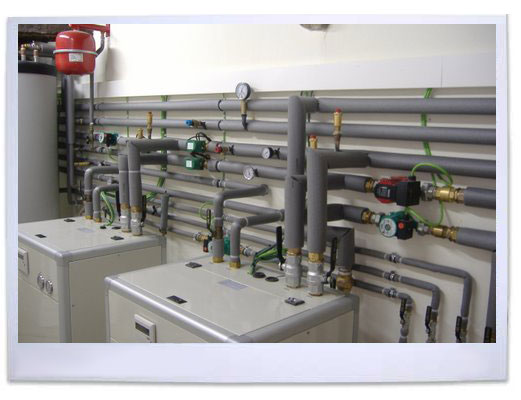
It got its name because of the distributor - the collector. Represents connecting element, from which there are several lines. It is he who distributes the general flow through separate pipes. More applicable to country house, in large commercial facilities, in luxury housing, in new buildings.
Thanks to the collectors, water is evenly distributed over all lines and the same pressure is ensured in the system.
The scheme involves choosing the optimal location of the collector, taking into account ease of use. The manifolds have (but not all) shut-off valves, they block water on certain piping lines in the system. They must be freely accessible.
The collector scheme has variations. But its traditional execution looks like this: two lines, one of which supplies hot water, the other cold. It includes:
- Ball Valves;
- emergency ball valve for hot water supply and the same for cold water supply;
- fine and coarse filters;
- counter;
- pressure reducer;
- and, of course, the collector itself.
The advantages of collector wiring are mass:
- reliability;
- the ability to carry out work, prevention, turning off one of the lines without prejudice to others;
- uniform pressure;
- the ability to install (think in advance) an individual filter system.
At the same time, the implementation of such a complex plan requires more effort and knowledge in design and installation.
In old houses
Of course, in the water supply systems in Khrushchev, Stalin and other multi-storey buildings of the old building there will be significant differences with the pipeline of the new building.
For example, in new houses they are mainly used for water supply. And try to replace part of the pipe in Stalin with plastic variety- get only dampness all over the floor, walls due to the constantly formed condensate.
Also, the difference will be noticeable when you start planning the location of water supply points - it directly depends on the features of the layout.
There are many nuances in the construction of the pipeline in old houses and new buildings, as well as in a private house and in an apartment. The first option is always more complex, improved and requires taking into account a lot of recommendations and features (for example, the length of the highway, the presence of additional devices, lines).
Materials and tools
Consider everything you need to create a pipeline in an apartment:
- First of all, of course, you need to purchase pipes. Plastic, metal-plastic, copper - the range is huge. And each variety has its own prices, its advantages and disadvantages. The choice is yours. The main thing is to choose the right diameter in accordance with the required water pressure, with the length of the line, with the number of household appliances. The principle applies here: the greater the need, the larger the diameter.
- You will need the following additional materials:
- fasteners;
- adapters;
- hoses, taps and other materials for plumbing and household appliances.
- From professional equipment prepare welding machine, perforator, angle grinders.
- Hand tools: tape measure, level, hammer.
- Means of protection.
Sequence of work
The instruction for manifold pipe routing is a step-by-step action plan:
- First, turn off the water in the building, in the apartment (house).
- We install ball valves - emergency at the entrance to the main risers. Do not forget about the prevention of leaks - about shut-off valves.
- Coarse filters.
- DHW and cold water meters, in accordance with the plan-drawing.
- We carry out the installation of gearboxes. They help prevent damage to the system if a sudden pressure drop occurs. Reducers are installed if the pressure in the riser is too high (higher than the throughput of other plumbing devices). So that the excess does not merge into the sewer system, a special drain should be built at this stage.
Mount the pressure gauge vertically. Install shut-off valves. Make sure that the arrow of the device correctly displays the direction of the water.
- Collector - should be in place. They have a maximum of 4 outputs. If you need more, you should purchase another collector.
- We lay pipes. Many recommend plastic pipes, they are easier to install without the help of professionals. But they are not always good option. For example, in old houses, as we noted in this article, if you choose an inexpensive model, you can regret it very quickly.
Installation is carried out as follows:
- if necessary, the pipes are cut to size;
- welded into joints.
- We check the system. You will need an assistant for this purpose. Shut off the water supply if you find a leak due to poor assembly of the system elements.
If the specified installation technology was observed exactly according to individual scheme, you will not have problems with plumbing for a long time.
If you are preparing to do all the work yourself, pay attention to the advice of the masters. They recommend saving and following a number of rules:
- there should be a minimum of joints, as well as adapters - this will save money and at the same time increase the reliability of your water supply system;
- it is necessary to strictly observe the technology of connecting pipes in appropriate places;
- implement the installation scheme in sequence to obtain a normal pressure distribution. Purchase a pipe with a larger diameter to install it at the connection point. So you will achieve normalization of pressure.
- do not forget about emergency taps - install them in problem areas and at the connection point in order to be able to turn off the water in the right places at any time;
- hoses should also be kept to a minimum. They do not provide tightness, and do not withstand pressure drops.
Approach the issue with professional enthusiasm and vigilance. The layout of the water supply pipes in the apartment, if all the work is done correctly, will provide you with an uninterrupted supply of water and give you a comfortable stay.
In a typical city apartment, we are used to seeing a simple and unpretentious scheme for connecting plumbing fixtures: a pair of valves with or without filters comes from the risers, and from them pipes are teeed with tees to the toilet bowl and faucets.
However, sometimes another type of wiring can be used - collector. Let's see what it is and what great benefits it has.
feel the difference
First, let's give clear and precise definitions of the main types of wiring.
- tee(serial) circuit. All plumbing fixtures are connected to the same pipe through tees. At the same time, nothing prevents in front of each of them to put shut-off valves specifically for it.
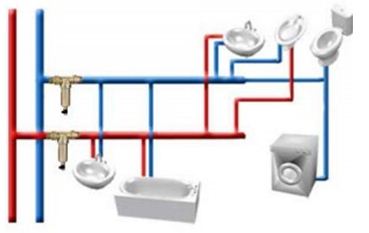
- Collector. Shut-off valves are concentrated on entering an apartment, house or anywhere else.
The key difference is that all the valves are nearby and from them to each device, whether it is a toilet, a mixer or a radiator, there is an independent pipe or a pair of pipes.
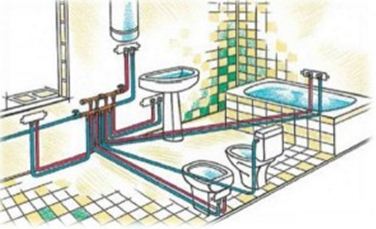
- mixed. Mix of both options. Let's say on remote in different directions a washbasin and a shower stand a collector and independent pipelines, and a toilet bowl, a bidet and washing machine- a common tee.
Please note: collector wiring is used not only for plumbing or heating on the scale of a separate apartment.
All sewerage of a quarter or a microdistrict also drains into a sewer.
Although within a block sewer systems can be consistent: when laying pipes underground, builders try to save within reason.
Bonuses and costs
Flaws
Let's start with the reverse side of the coin. What's wrong with collector wiring? Why don't we see it in every apartment?
The secret, in general, is simple: it requires more materials and work. If the shower and washbasin are nearby, with a serial scheme, five meters of pipes will be required to connect them, and with a collector, eight meters. The combs themselves ( shut-off valves for several consumers, mounted together for ease of installation) are also expensive.
In addition, if it is not accompanied by a global renovation in the apartment, there is a big difference between two pipes running along the wall and, say, six.
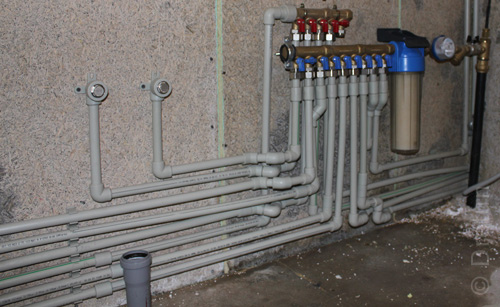
Tip: collector wiring is more often used, however, precisely when Big Repair when the pipes are laid in a screed or hidden under decorative boxes on the walls.
As we will see from the future, here the collector circuit will be very useful.
Advantages
And now we finally got to the quintessence of the article: to how many utilities and benefits a collector can bring in a heating or water supply system.
- All plumbing fixtures can be turned off and on from a single center. "So what?" - a resident of a city apartment will shrug his shoulders, in which the distance from the riser to the distant mixer does not exceed two meters.
My friend, in addition to the layout you are used to, there are also mini-hotels, guest rooms, offices, and so on and so forth. Imagine that you saw a puddle crawling out from under the guests' door. And they themselves, along with the keys to this door, are away. s? - IN easy and convenient adjustment of the patency of pipes for each device separately is possible. You can press the throttle on the battery, which does not need to be heated so much in a warm spring: it’s warm, we are increasingly paying on the meter!
You can limit the flow of water in the washbasin, which is used by children prone to pranks. Why do we need puddles on the floor and excess spilled water, for which, again, we pay?
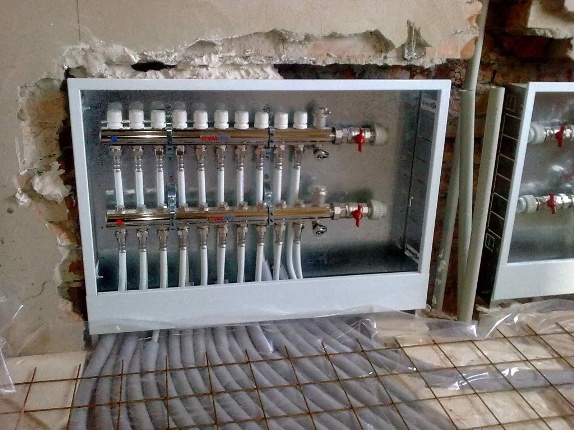
Centralized Control Panel is convenient
- In the case of plumbing, with the correct collector wiring, the “bottleneck effect” is eliminated: when someone from the household flushed after himself in the toilet, you will not be scalded with boiling water in the shower.
- Finally, the main advantage. Where do pipes most often flow? That's right, connections. Any experienced plumber will attest to: modern materials leak in the middle of the pipe only after a sophisticated and long abuse like repeated defrosting or driving a tractor through the pipe. caterpillar.
So, collector wiring allows you to lay a straight pipe from the collector to any device without connections. And then hide it under a screed or drywall, without fear for the consequences.
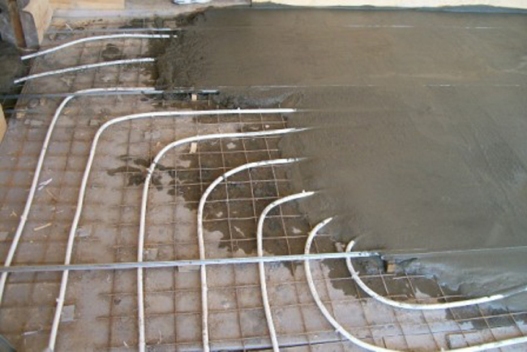
Implementation
There are few subtleties here, but they are still there.
Heating
Pipes to heaters will be of different lengths. This is an axiom.
Even modern pipes made of smooth plastics have a certain hydraulic resistance, directly proportional to the length of the pipe. Nobody canceled the heat loss in the pipeline.
If so, then in order to equalize the temperature of the radiators, we need to adjust (balance) the heating system. Therefore, we will forget about ordinary valves and put a pair of throttles on each heater.
By steam - so that you can not only slow down the circulation, but also completely cut off the heater. A throttle and ball valve combination is also an option.
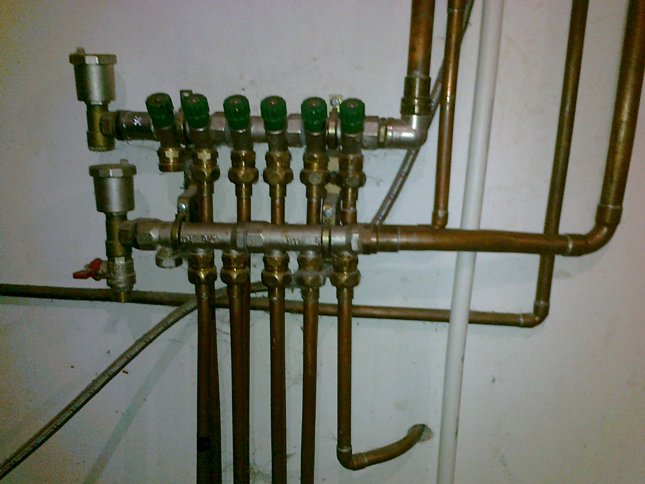
Water supply
To avoid the notorious boiling water in the shower when another faucet is open or a tank is being filled, a certain ratio of pipe diameters is needed. If the wiring to the washbasin, shower and cistern is made with a half-inch pipe, then the input to the collector or the section from the riser should be a step thicker.
doubled larger diameter there is no need: the permeability of the pipe is proportional to the square of its diameter. If it has become a quarter larger, the cross-country ability has increased by more than one and a half times.
It is better to put the filter in common, before the collector. Hydrodynamics and patency have nothing to do with it - it's easier to maintain the water supply. Of course, you will need a diameter no smaller than that of the input. The filter can also become a bottleneck.
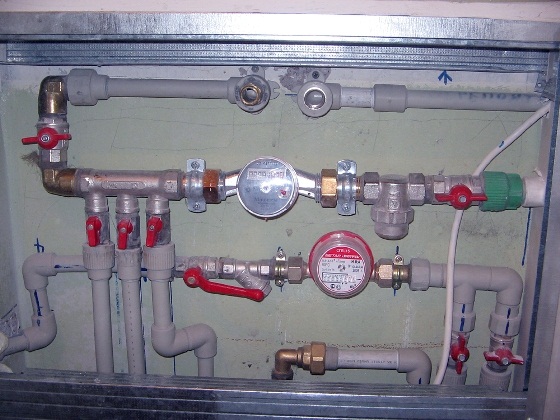
Finally: in the case of polyethylene or polypropylene on welds, correctly made joints are as strong and reliable as a solid pipe. They can be easily laid in a screed.
Tip: Just don't forget about thermal expansion. made of reinforced polypropylene.
Conclusion
As you can see, there are few difficulties here, but the benefits are great. Do not forget that with collector wiring you save on tees, which in the case of metal-plastic are much more expensive than several additional running meters pipes. However, of course, it's up to you to decide. Good luck with the repair!
When starting a renovation, we rarely limit ourselves to one room. The updated interior begins to discord with the rest of the premises, and somehow not only new wallpapers, the color of the floor and ceiling, but also the furniture in other rooms suggest themselves. And if we are talking about overhaul, then it will affect everything and everyone: electrical wiring, sound insulation, heating and air conditioning systems, even plumbing in the apartment. As you know, plumbing is a system technical devices(fittings, valves, filters) and pipes for supplying water to different points of the apartment. Plumbing can be done in the classic tee way or modern manifold.
Classics of the genre - tee wiring diagram
The tee wiring diagram for the water supply in an apartment is a series of pipes from a common riser to places of water consumption (faucets, showers, toilets, dishwashers or washing machines).
First, the main pipes with cold and hot water, and then branches are made from them using tees.
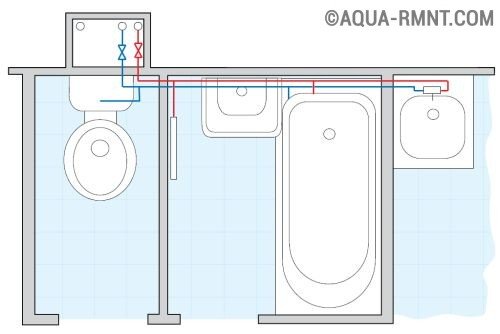
The tee scheme is the cheapest option. When designing the wiring, the plumber should talk about it and the collector circuit, as well as the cost of both options.
Advantages of the classic scheme:
- low cost;
- compactness;
- ease of installation.
Disadvantages of this wiring system:
- pressure drops caused by the simultaneous inclusion of two points of water consumption;
- it is impossible to block one consumer, you will have to turn off the water in the entire apartment;
- it is not always possible to conveniently place tees on the area of \u200b\u200bthe bathroom.
In some cases, it is possible to avoid a complete shutdown of water during repair work. To do this, you need to put a tap in front of the plumbing, which, if necessary, can be blocked.
The tee scheme is more suitable for a small apartment, in which it is easy to coordinate water consumption at different points. But such plumbing in a private house can cause a lot of inconvenience, especially in large cottages. For them, a collector circuit is more convenient.
Collector scheme - ideal for a large house
Collector distribution of water supply means bringing separate pipes to each point of water consumption. A sink in the kitchen, a toilet, a shower - each faucet in the house supplies water in the right amount, regardless of the others. Pipes are supplied from a collector installed at the inlet of the water supply to the house. It is a device with one input and several outputs. Their number is selected based on the number of points of water consumption. In this case, it is necessary to take into account not only the taps, but also the washing and dishwasher, outdoor water, etc.
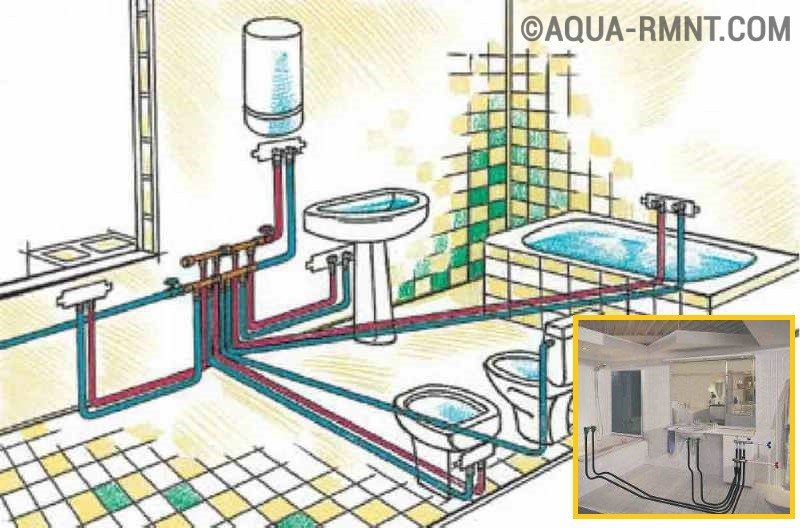
Here it is clearly seen that all points of water consumption are independent of each other. It is very convenient for both operation and repair.
The collector can only be installed after the water filters and pressure reducers are connected.
![]()
This is what the collector looks like under the sink. Agree, not very convenient for an ordinary apartment. It even looks like an airplane dashboard.
This scheme has many advantages. Firstly, without prejudice to the household, you can turn off the water in the shower, while leaving the possibility of using other bathrooms.
Secondly, all taps for controlling the water supply system are located in one place, they are easily accessible. As a rule, the collector is located in a sanitary cabinet or a separate room.
Thirdly, stable pressure in the system. Collector wiring protects against surges, thereby ensuring that you will not be splashed with boiling water in the shower if someone turns on the water in the kitchen.
Fourthly, the minimum risk of breakdowns and ease of repair, because only one solid pipe runs from the tap to the manifold.
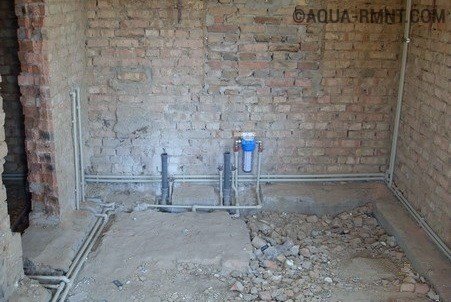
In a private house, when using a collector circuit, water pipes can be hidden even under a screed: the probability of breakage of solid pipes is negligible
Fifth, the water temperature at all points of water consumption is the same, even if all taps are opened at the same time.
Sixthly, the connection of new taps or water-powered equipment is carried out quickly, without prejudice to other consumers. To do this, you only need to install a collector with a margin of several conclusions.
Everything has its drawbacks, and the collector method is no exception. He demands a large number building materials. Two pipes are not enough here. And this, in turn, leads to significant material costs. Yes, and the installation of water supply according to this scheme takes a lot of time.
In addition, a lot of space is needed to accommodate the collector and so many pipes. You can no longer hide the place where the water supply enters the apartment behind the locker, it does not look aesthetically pleasing.
Which water pipes to choose depending on the wiring diagram
If the apartment has wiring water pipes will be carried out according to the tee scheme, it is better to use plastic or polypropylene pipes.
Connections plastic pipes performed by special welding. Threaded metal connections are mounted in polypropylene fittings (connection details).
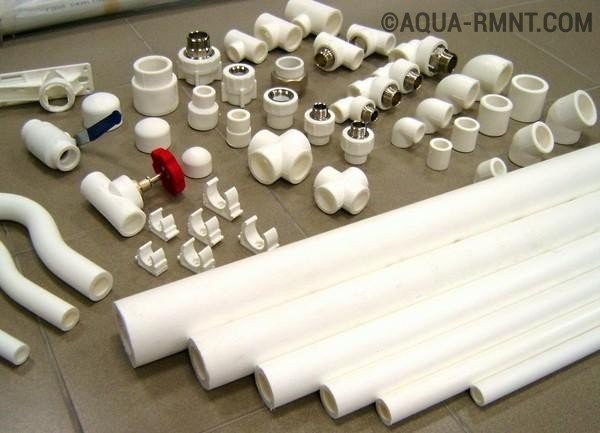
Polypropylene pipes are the most affordable on the market. They are lightweight and will last about thirty years.
Plumbing linen, pastes or FUM tape are used as seals. The latter is a sealing fluoroplastic material.
For wiring in a collector way, it is necessary to use metal-plastic water pipes.
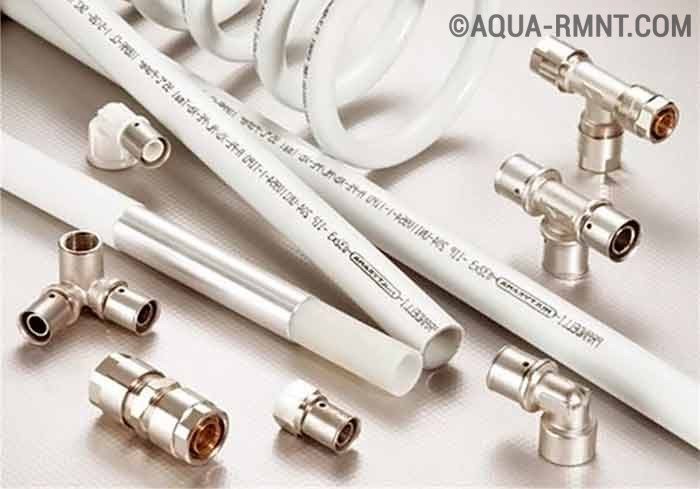
When it comes to renovating a bathroom, replacing the plumbing lines is a must. Moreover, it is not always about dismantling old pipes and laying new ones in their place. As a rule, if the owner undertakes a cardinal arrangement of the bathroom, it involves improving the ergonomics of the usable space, combining or vice versa separating the bathroom and toilet, installing modern plumbing and household appliances, and improving the design. Naturally, such events are associated with the laying of both new water mains and drainage ones. In a word, a new piping in the bathroom will be required.
How to develop a wiring diagram?
A professionally designed bathroom transformation plan is key point when creating comfort and coziness in a home, in principle, in order to end up with a single system, which means that all its elements must be “linked” with each other in such a way that the operation of each of them individually is as functional and efficient as possible.
As for the bathroom, correct system in the bathroom even with minimal overall dimensions turn it into a corner of comfort and relaxation. To begin with, a clear layout of all plumbing products to which this or that pipeline will be connected is developed. Here it should be noted that if the toilet is a separate room, then the piping in the toilet should be carried out in conjunction with the bathroom.
Before you get to know all the nuances correct installation, we offer to see good example a job well done.
Video: how to separate pipes in the bathroom and toilet
Choosing the right mounting method
After a thorough study of the sketch, where all the markings and dimensions are applied, and a well-thought-out wiring diagram, you will have to think about how all this will be implemented in practice. In principle, there should not be any particular difficulties with this, since pipes can be separated in one of two ways - open or hidden.
The open method is when the communication pipelines are outside. Characterized by easy execution installation work However, the aesthetic parameters leave much to be desired. Even if all communications will pass as close as possible to the floor surface.
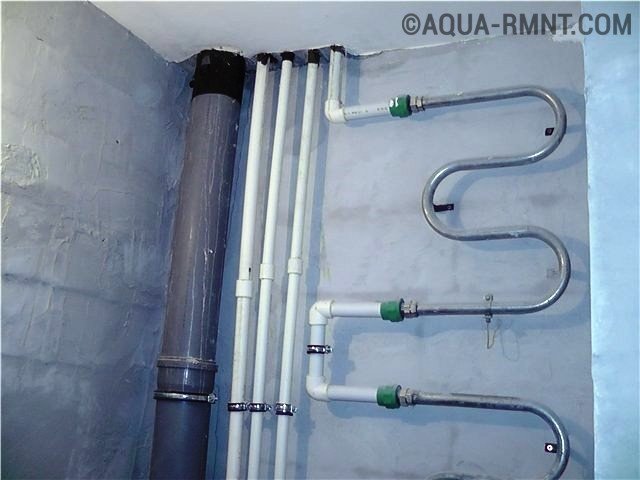
There is no need to talk about aesthetics - definitely ugly
The hidden method implies that the pipes are hidden in wall structures. Here, everything is in order with visual perception - the highways simply will not be visible. But to perform installation in this way is an extremely difficult event. A lot of effort will take, for example, gating. It is important to note that wall gating with hidden wiring cannot be performed in load-bearing walls.
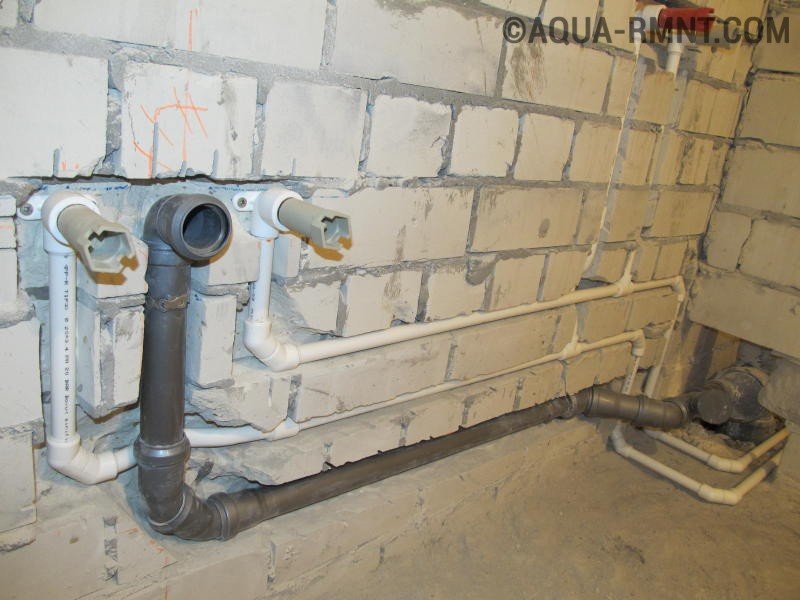
At the end finishing works pipes will not be visible at all
We continue to work with the wiring diagram, now we need to decide how the pipes will be physically laid: in series, collector, with through-hole sockets. The latter is practically not used in everyday life, so we will leave it to professionals. Let's take a closer look at the first two methods.
Consistently
The advantages of this option are that everything is extremely simple and clear: the main pipeline is laid in stages, connecting one device to another. From an installation standpoint, it's a great choice.
There is only one drawback - during operation, uneven distribution of water pressure, if several devices are used simultaneously.
With manifold
This method involves the installation of a valve on each pipe leading to the device. This will allow repair without shutting down the entire system. Collector wiring is the creation of a separate section of the pipeline for each device. Provides uniform distribution of water to water intake points. A "novice plumber", however, this method may be too tough - it requires a lot of patience and labor. Well, plus everything else, it turns out an increased consumption of materials.
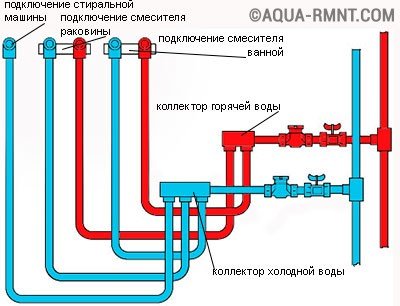
Such wiring is quite difficult to install - consider whether it is worth taking on it yourself
Whichever option is preferred, in any case, the following conditions must be met: the minimum possible number of connecting nodes and bends of the mains, as well as the maximum integrity. Overlaps of highways cold and hot water are allowed only in exceptional cases with complex water supply, and in general, the wiring of water supply and drainage pipes should have a finished concise appearance.
Algorithm for performing installation work
The very first step, whether it be hidden system or open, is the installation of a control valve. Given the fact that the quality of the supplied water from the central water conduit is, to put it mildly, unsatisfactory, the installation of

